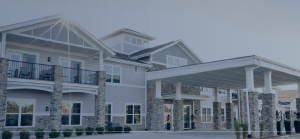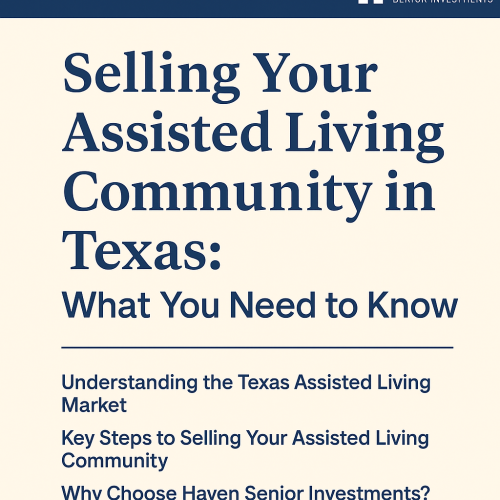On March 27, 2020, the President of the United States signed the Coronavirus Aid, Relief, and Economic Security Act (CARES Act), aimed at providing financial relief to the American people and American businesses in response to the economic fallout from the fast-developing coronavirus (COVID-19) pandemic. The measure provides direct financial aid to American families, payroll and operating expense support for small businesses, and loan assistance for distressed industries.
One of the core pieces of the CARES Act is the provision of $349 billion for small businesses (including senior housing providers) through federally backed loans under a modified and expanded Small Business Administration (SBA) 7(a) loan guaranty program called the Paycheck Protection Program. Congress has designed the program to make funds available to qualifying businesses quickly through approved banks and nonbank lenders.
Key Points
Loans will be available through SBA and Treasury approved banks, credit unions, and some nonbank lenders.
Borrowers can borrower 2.5 times their monthly payroll expenses, up to $10 million.
Applicable uses for the loan proceeds include: (1) qualified payroll costs; (2) rent; (3) utilities; and (4) interest on mortgage and other debt obligations.
Loan forgiveness is available for funds used to pay 8 weeks of payroll and other qualified expenses.
Borrower FAQs
What businesses qualify for the Paycheck Protection Program?
According to the language of the bill, generally, any business in operation on February 15, 2020 with no more than 500 employees (or which meets the applicable size standard for the industry as provided by SBA’s existing regulations) is eligible. This includes small businesses, as well as qualified nonprofit organizations, sole proprietorships, independent contractors, and self-employed individuals. A business in the accommodation and food services industry with more than one physical location qualifies if it employs no more than 500 employees at each location. For purposes of eligibility, the SBA’s affiliate rules are waived for businesses in the hospitality and restaurant industries, franchises approved on the SBA’s Franchise Directory, and small businesses that receive financing through the Small Business Investment Company program.
- What is the maximum loan amount that a business can receive through the Paycheck Protection Program?
Each business can receive the lesser of $10 million or the sum of 2.5 times the average total monthly payroll costs for the prior year. What can a business use Program funds for?
Businesses can use funds from the Program loans to cover expenses including:
Payroll costs, including compensation to employees; payments for vacation, parental, family, medical or sick leave; severance payments; payments required for group health care benefits (including insurance premiums), retirement benefits, and state and local employment taxes.
Interest payments on any mortgage obligations or other debt obligations incurred before February 15, 2020 (but not any payments or prepayments of principal).
Rent
Utilities
However, the money cannot be used for compensation of individual employees, independent contractors, or sole proprietors in excess of an annual salary of $100,000; compensation of employees with a principal place of residence outside the United States; or leave wages already covered by the Families First Coronavirus Response Act.
- How are loans made under this Program different from traditional 7(a) loans?
Unlike traditional SBA 7(a) loans, no personal guarantee will be required to receive funds and no collateral needs to be pledged. Similarly, the CARES Act waives the requirement that a business shows that it cannot obtain credit elsewhere. In lieu of these requirements, borrowers must certify that the loan is necessary due to the uncertainty of current economic conditions; that they will use the funds to retain workers, maintain payroll, or make the lease, mortgage, and utility payments; and that they are not receiving duplicative funds for the same uses.
Payments of principal, interest, and fees will be deferred for at least 6 months, but not more than 1 year. Interest rates are capped at 4%. The SBA will not collect any yearly or guarantee fees for the loan, and all prepayment penalties are waived.
The SBA has no recourse against any borrower for non-payment of the loan, except where the borrower has used the loan proceeds for a non-allowable purpose.
What are the loan forgiveness requirements?
Borrowers are eligible for loan forgiveness for 8 weeks commencing from the origination date of the loan of payroll costs and rent payments, utility payments, or mortgage interest payments. Eligible payroll costs do not include annual compensation greater than $100,000 for individual employees.
The amount of loan forgiveness may be reduced if the employer reduces the number of employees as compared to the prior year, or if the employer reduces the pay of any employee by more than 25% as of the last calendar quarter. Employers who re-hire workers previously laid off as a result of the COVID-19 crisis will not be penalized for having a reduced payroll for the beginning of the relevant period. Forgiveness may also include additional wages paid to tipped workers.
Borrowers must apply for loan forgiveness to their lenders by submitting required documentation (as discussed in further detail below) and will receive a decision within 60 days.
If a balance remains after the borrower receives loan forgiveness, the outstanding loan will have a maximum maturity date of 10 years after the application for loan forgiveness.
How does a business apply for a loan under the Paycheck Protection Program?
We expect additional guidance from the SBA regarding how to apply for Program loans, including additional resources on the SBA website about how to find a qualified lender. Borrowers who have outstanding SBA loans may also want to contact their existing lenders to inquire about applying for loans under the Program.
Does the CARES Act affect any other loans available to small businesses?
Yes. The maximum loan amount for an Express Loan is increased from $350,000 to $1 million.
The CARES Act also expands eligibility for borrowers applying for an Emergency Economic Injury Disaster Loan (EIDL) grant. Under the Act, emergency EIDLs are available for businesses or cooperatives with fewer than 500 employees, sole proprietors or independent contractors, or Employee Stock Ownership Plans (ESOPs) with fewer than 500 employees. Additionally, the Act waives requirements that (1) the borrower provides a personal guarantee for loans up to $200,000, (2) that the eligible business is in operation for one year prior to the disaster, and (3) that the borrower is unable to obtain credit elsewhere. The SBA is also empowered to approve applicants for small-dollar loans solely on the basis of their credit score or “alternative appropriate methods to determine an applicant’s ability to repay.”
Most significantly for borrowers seeking an immediate influx of funds, borrowers may receive a $10,000 emergency advance within three days after applying for an EIDL grant. If the application is denied, the applicant is not required to repay the $10,000 advance. Emergency advance funds can be used for payroll costs, increased material costs, rent or mortgage payments, or for repaying obligations that cannot be met due to revenue losses.
Borrowers may apply for an EIDL grant in addition to a loan under the Paycheck Protection Program, provided the loans are not used for the same purpose. If a borrower received a loan under 7(b)(2) after January 31, 2020, the borrower may refinance the outstanding balance as part of a loan under the Program.
- Is relief available for businesses with pre-existing SBA loans?
Yes. The SBA will pay the principal, interest, and associated fees on certain pre-existing SBA loans for 6 months.
Lender FAQs
Which lenders may process, close, disburse, or service loans made under the Paycheck Protection Program?
To participate in the Paycheck Protection Program, lenders must be either SBA Qualified Lenders—those already deemed qualified under section 7(a)—or Additional Lenders—those insured depository institutions, insured credit unions, and other lenders that the Administrator and Secretary of the Treasury determine are qualified pursuant to paragraph (36) (together, Program Lenders).
The Program permits the Administrator to delegate authority to Additional Lenders for purposes of making and approving covered loans to eligible borrowers during the covered period. Pursuant to the Program’s “Delegated Authority” provisions, the Administrator and Secretary of the Treasury shall designate as Additional Lenders those that have the “necessary qualifications to process, close, disburse and service loans” made with the guarantee of the SBA.
Specific criteria for Additional Lenders are not included in the Act. It contemplates that “the Department of the Treasury, in consultation with the Administrator, and the Chairman of the Farm Credit Administration shall establish criteria.” A lender may not participate in the Program if doing so would affect its safety and soundness, as determined by the Secretary of the Treasury.
How much of the loan will the SBA guarantee under the Paycheck Protection Program?
The SBA will guarantee (through deferred participation) 100 percent of any covered loan made under the Program during the covered period. This is a substantial increase from the 75 percent guarantee against traditional SBA loans made under section 7(a).
What due diligence must Program lenders conduct prior to extending loans under the Program?
Prior to the extension of any loan under the Program, the Program Lender must evaluate the eligibility of each borrower that applies for a covered loan. Under the Program, a Program Lender must consider whether the applicant:
- Was in operation on February 15, 2020; and
- Had employees for whom the borrower paid salaries and payroll taxes, or paid independent contractors, as reported on a Form 1099-MISC.
What are the terms and conditions of Program loans?
Unless otherwise provided the terms and conditions for a covered loan will be the same as the related terms and conditions for traditional SBA 7(a) loans. The Secretary of the Treasury may issue regulations and guidance regarding loan terms. As discussed above, if a borrower on a covered loan applies for the loan to be forgiven, any remaining balance will have a maximum maturity of 10 years from the borrower’s application for such forgiveness. The maximum interest rate for covered loans is 4%.
What capital, reserves, and fees incentives are there for depository institutions to participate in the Program?
Covered loans on an institution’s balance sheet will be risk rated at 0%, meaning there is no requirement to hold capital against these assets. Effectively, covered loans will be treated as being as low risk as U.S. Treasuries. Also, if a covered loan is modified due to COVID-19-related difficulties, the financial institution will not be required to report the modification as a troubled debt restructuring until such time as the federal banking agencies determine it is appropriate. (The federal banking agencies have issued separate guidance regarding similar treatment for modifications of other loans due to COVID-19.)
Program Lenders, including banks, will be reimbursed for covered loan processing fees. The reimbursement rate is based on the disbursed loan balance: 5% for covered loans up to $350,000, 3% for covered loans greater than $350,000 and less than $2 million, and 1% for all other covered loans.
Additionally, the SBA will coordinate with the Federal Deposit Insurance Corporation, the Office of the Comptroller of the Currency, and state bank regulators “to encourage those entities to not require lenders to increase their reserves” due to receiving payments from the SBA on covered loans.
Can a lender sell these loans on the secondary market?
Covered loans may be sold on the secondary market. If a covered loan is sold on the secondary market, and an investor declines to approve a deferral request by a lender, the SBA will purchase the loan so that the impacted borrower may receive a deferral period of 6 months to a year (including payment of principal, interest, and fees).
What documents must a lender require to offer a borrower loan forgiveness?
As discussed above, loan forgiveness is available for 8 weeks of payroll costs, mortgage interest or rent payments, and utility payments. To be eligible to receive loan forgiveness, a borrower must submit a complete application to the lender containing the following required documents:
- Documentation verifying the number of full-time equivalent employees on payroll and pay rates for pre- and post-covered periods, including payroll tax filings, reported to the IRS and state income, payroll, and unemployment insurance filings;
- Documentation such as canceled checks verifying mortgage interest, lease, and utility payments;
- Certification from a representative of the recipient that (a) the documentation presented is true and correct, and (b) the amount for which forgiveness is requested was used to retain employees, make interest payments on a covered mortgage obligation, make payments on a covered rent obligation or make covered utility payments; and
- Any other documentation the SBA deems necessary.
Footnote
1 The CARES Act does not indicate that SBA revenue size standards are applicable; the SBA’s forthcoming regulations may clarify this issue.
2 For the purposes of determining the number of employees, the term “employee” includes individuals employed on a full-time, part-time, or other basis.
3 Businesses must have a North American Industry Classification System Code beginning with 72 to be eligible.
4 Businesses that received a disaster loan under § 636(b)(2) after January 31, 2020, may also include the outstanding balance of that loan.
5 The Secretary of Treasury’s regulations and guidance may include (i) allowing additional lenders to originate loans and (ii) establishing terms and conditions for loans, including terms and conditions concerning compensation, underwriting standards, interest rates, and maturity.
6 See Bank Regulators Promote Loan Modifications by Easing Certain Reporting Requirements






